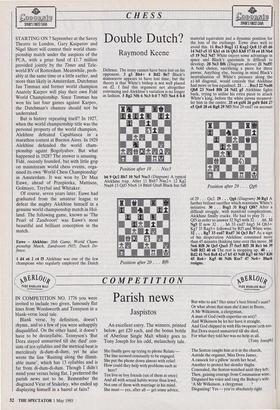Double Dutch?
Raymond Keene
STARTING ON 7 September at the Savoy Theatre in London, Gary Kasparov and Nigel Short will contest their world cham- pionship match under the auspices of the PCA, with a prize fund of £1.7 million provided jointly by the Times and Tele- world BV of Rotterdam. Meanwhile, prob- ably at the same time or a little earlier, and more than likely in Amsterdam, Dutchman Jan Timman and former world champion Anatoly Karpov will play their own Fide World Championship. Since Timman has won his last four games against Karpov, the Dutchman's chances should not be underrated.
But is history repeating itself? In 1927, when the world championship title was the personal property of the world champion, Alekhine defeated Capablanca in a marathon contest at Buenos Aires. In 1929 Alekhine defended the world cham- pionship againt Bogolyubov. But what happened in 1928? The answer is amusing. Fide, recently founded, but with little grip on mainstream world chess events, orga- nised its own 'World Chess Championship' in Amsterdam. It was won by Dr Max Euwe, ahead of Przepiorka, Mattison, Golmayo, Treybal and Whitaker. Of course, seven years later, Euwe had graduated from the amateur league to defeat the mighty Alekhine himself in a genuine world championship match in Hol- land. The following game, known as 'The Pearl of Zandvoort' was Euwe's most beautiful and brilliant conception in the match.
Euwe – Alekhine: 26th Game, World Cham- pionship Match, Zandvoort 1935; Dutch De- fence.
1 d4 e6 2 c4 f5 Alekhine was one of the few champions who regularly employed the Dutch Defence. Theirony cannot have been lost on his opponent. 3 g3 Bb4+ 4 Bd2 Bel Black's manoeuvre appears to have lost time, but the theory is that White's bishop is not well placed on d2. I find this argument not altogether convincing and Alekhine's variation is no longer in fashion. 5 Bg2 Nf6 6 Nc3 0-0 7 Nf3 Ne4 8 0-0 Position after 10 . . . Nxc3 b6 9 Qc2 Bbl 10 Ne5 Nxc3 (Diagram) A typical Alekhine trap. After 11 Bxb7 Nxe2+ 12 typical
Nxd4 13 Qd3 Nbc6 14 Bta8 Qxa8 Black has full
Position after 20 . . . Bf6 material equivalent and a dynamic position for the loss of the exchange. Euwe does well to avoid this. 11 Bxc3 Bxg2 12 1042 Qc8 13 d5 d6 14 Nd3 e5 15 Khl c6 16 Qb3 Kh8 17 f4 e418 NM c5 19 Nc2 Nd7 White enjoys some advantage in space and Black's queenside is difficult to develop. 20 Ne3 Bf6 (Diagram above) 21 Nxf51 A bold choice, sacrificing a piece for three
ri
pawns. Anything else, bearing in mind Black's neutralisation of White's pressure along the al-h8 diagonal, would concede that Alekhine had more or less equalised. 21 . . . Bxc3 22 Nxd6 Qb8 23 Nxe4 Bf6 24 Nd2 g5 Alekhine fights back, trying to utilise his extra piece to attack White's king, before the white pawns steamrol- ler him in the centre. 25 e4 gxf4 26 gxf4 Bd4 27 e5 Qe8 28 e6 Rg8 29 Nf3 Not 29 exd7 on account Position after 29 . . . Qg6 of 29 . . . Qe2. 29 . . . Qg6 (Diagram) 30 Rgl A further briliant sacrifice which maintains White's initiative. 30 . . . Bxgl 31 Rxgl Q16? After a difficult struggle, with manifold complications, Alekhine finally cracks. He had to play 31 . . . Qf5 in order to answer 32 Ng5 with 32 . . . h6. 32 Ng5 If now 32 . . . h6 33 exd7 hxg5 34 Qh3+ Kg7 35 Rxg5+ followed by Rf5 and White wins. 32 . . . Rg7 33 exd7 Rxd7 34 Qe3 Re7 As a sign of his desperation Alekhine consumed more than 45 minutes thinking time over this move. 35 Neb Rf8 36 Qe5 QxeS 37 fxe5 Rf5 38 Rel h6 39 Nd8 Rf2 40 e6 The rest is mopping up. 40 . . . Rd2 41 Nc6 Re8 42 e7 b5 43 Nd8 Kg7 44 Nb7 Kf6 45 Re6+ Kg5 46 Nd6 Rxe7 47 Ne4+ Black resigns.


























































 Previous page
Previous page